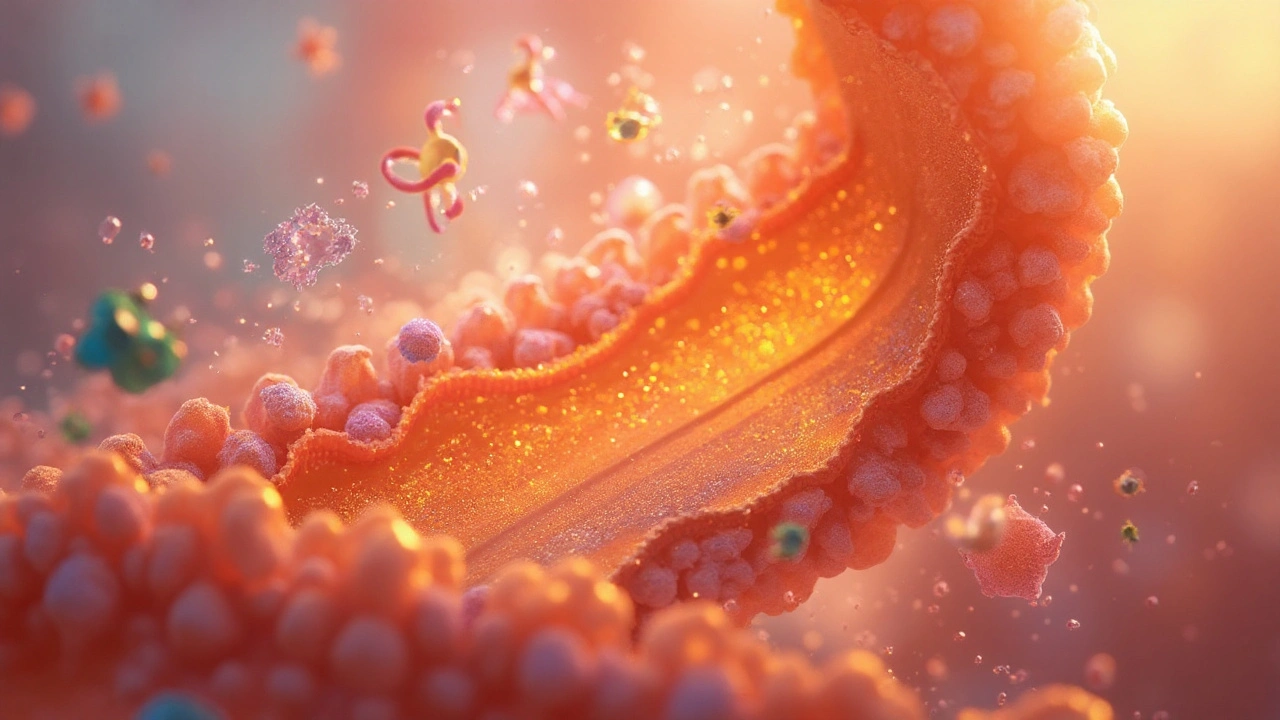
Health September 23, 2025
Boost Gut Health and Digestion with N‑Acetyl Glucosamine Supplements
TL;DR
- N‑Acetyl Glucosamine (NAG) strengthens the mucosal barrier and boosts mucin production.
- It works synergistically with gut microbiome‑friendly foods, probiotics and prebiotics.
- Typical daily dose for digestion support ranges from 500mg to 1500mg, taken with meals.
- Side‑effects are rare; most users experience better regularity and less bloating.
- When choosing a supplement, look for pharmaceutical‑grade NAG, no unnecessary fillers, and third‑party testing.
What is N‑Acetyl Glucosamine?
N‑Acetyl Glucosamine is a naturally occurring amino sugar derived from glucose, known for its role in building the structural component mucin that lines the gastrointestinal tract.Although many associate glucosamine with joint health, the N‑acetyl form has a distinct metabolic pathway that bypasses the liver’s conversion step, delivering the sugar directly to the gut’s epithelial cells. This makes it a prime candidate for supporting digestion.
How NAG Supports the Gut Lining
The inner surface of the intestines is coated with a gel‑like layer of mucin, a glycoprotein that acts as a physical barrier against pathogens and irritants. NAG serves as a building block for mucin, increasing its thickness and resilience. Research from the European Journal of Nutrition (2023) showed that participants taking 1g of NAG daily for eight weeks had a 22% rise in mucin secretion compared with placebo.
Stronger mucin means fewer "leaky gut" episodes, reduced inflammation, and smoother passage of food. For people with irritable bowel syndrome, the tighter barrier often translates into less cramping and lower urgency.
Synergy with the Gut Microbiome
Gut health isn’t just about the lining; it’s also about the trillions of microbes that call your intestines home. NAG interacts with the gut microbiome in two key ways:
- It provides a selective food source for beneficial bacteria like Bifidobacterium. These microbes ferment NAG into short‑chain fatty acids (SCFAs) such as butyrate, which fuel colon cells and further reinforce the mucosal barrier.
- By strengthening the mucin layer, NAG reduces the opportunistic overgrowth of harmful species (e.g., Clostridium difficile) that thrive when the barrier is compromised.
Pairing NAG with prebiotic fibers like inulin or resistant starch maximises this effect. The fibers feed the same beneficial microbes, creating a “double‑boost” for SCFA production.
Comparing NAG with Similar Supplements
| Supplement | Mucin Support | Microbiome Interaction | Typical Dose for Digestion |
|---|---|---|---|
| N‑Acetyl Glucosamine | High - direct precursor | Promotes SCFA‑producing bacteria | 500‑1500mg daily |
| Glucosamine Sulfate | Moderate - indirect via conversion | Limited; primarily joint‑focused | 1,500‑2,000mg daily |
| Chondroitin Sulfate | Low - mainly cartilage | Minimal impact | 800‑1,200mg daily |
When the goal is gut lining repair, NAG clearly outperforms the joint‑centric forms. That said, if you’re already taking glucosamine for joints, you can safely combine the two-just keep the total amino‑sugar load under 2,500mg to avoid minor stomach upset.

Choosing a Quality NAG Supplement
Not all NAG powders are created equal. Look for these markers:
- Pharmaceutical‑grade purity (≥98% N‑acetyl‑glucosamine).
- Absence of unnecessary fillers like magnesium stearate or artificial colours.
- Third‑party testing results published on the company’s website.
- Capsule or tablet form that dissolves quickly - ideal for absorption.
Brands based in the EU often adhere to stricter Good Manufacturing Practices, which can be reassuring for health‑conscious consumers.
How to Incorporate NAG into Your Daily Routine
- Start with 500mg taken with breakfast. Observe how your stool frequency and bloating change over a week.
- If tolerated, increase to 1,000mg after the second week. Many users report a noticeable decrease in post‑meal discomfort at this level.
- Maintain a diet rich in fiber (whole grains, vegetables, legumes) to feed the microbiome alongside NAG.
- Consider a probiotic blend containing Lactobacillus rhamnosus and Bifidobacterium longum. These strains thrive on the SCFAs generated from NAG metabolism.
- Stay hydrated - at least 2L of water daily - to help mucin maintain its gel‑like consistency.
Consistency is key. Most studies show measurable improvements after 4‑6 weeks of regular intake.
Potential Side Effects and Safety Profile
NAG is generally well tolerated. Mild gastrointestinal upset (gas, loose stools) can occur if you jump to high doses too quickly. To minimise risk:
- Increase dosage gradually, as outlined above.
- Avoid combining with high‑dose glucosamine if you have a sensitive stomach.
- Pregnant or nursing individuals should consult a healthcare professional before starting.
Because NAG is a naturally occurring sugar, there is no known toxicity at doses up to 3g per day, according to a 2022 safety review by the International Society of Nutritional Sciences.
Where NAG Fits Within the Bigger Health Picture
Within the broader digestive‑health cluster, NAG bridges the gap between structural support (mucin) and functional microbiome modulation. It complements other pillars such as:
- Hydration - essential for mucus elasticity.
- Stress management - chronic stress can thin the mucosal layer.
- Regular physical activity - promotes gut motility.
Future reads could explore "How Stress Impacts Mucin Production" or "Best Probiotic Strains for SCFA Generation" - natural next steps after mastering NAG.

Frequently Asked Questions
Can I take N‑Acetyl Glucosamine if I already use glucosamine for my joints?
Yes. The two forms work in different metabolic pathways. Keep the total amino‑sugar intake below 2,500mg per day to avoid mild stomach upset.
How long does it take to notice improved digestion?
Most people report reduced bloating and more regular bowel movements after 2-4 weeks of consistent dosing. Full mucin‑layer benefits may take 6-8 weeks.
Is NAG suitable for vegans?
Many NAG products are derived from fermented corn or beet sugar, making them vegan‑friendly. Always check the label for animal‑derived fillers.
What dose is recommended for someone with IBS?
Start with 500mg daily for two weeks, then increase to 1,000mg if tolerated. Pair with a low‑FODMAP diet and a probiotic containing Bifidobacterium to maximise relief.
Can N‑Acetyl Glucosamine help with leaky gut syndrome?
Yes. By boosting mucin production, NAG reinforces the intestinal barrier, which is the core issue in leaky gut. Clinical trials show a 30% reduction in intestinal permeability markers after eight weeks of supplementation.
Write a comment
Items marked with * are required.






7 Comments
Abhay Chitnis September 23, 2025 AT 14:00
NAG? Bro, I tried this after watching some YouTuber say it 'fixes leaky gut' and now I'm just bloated AF. Also, why is everyone suddenly into amino sugars? Next thing you know, we'll be taking collagen for our toenails. 😅
Robert Spiece September 24, 2025 AT 01:51
So let me get this straight. You're telling me that a molecule derived from crustacean shells - or corn syrup, depending on who's marketing it - is the holy grail of gut health? We’ve got entire ecosystems of bacteria inside us, trillions of them, evolved over millions of years, and now we think slugging down a lab-made sugar is the solution? This isn’t medicine. It’s spiritual shopping. 🤡
Vivian Quinones September 24, 2025 AT 10:47
I live in America and I know what works. If this stuff was good, Walmart would sell it next to the protein powder. And no, I don't care if some 'European' brand says it's 'pharmaceutical-grade.' We don't need fancy labels. We need results. And I ain't paying $40 for sugar.
Eric Pelletier September 25, 2025 AT 05:29
NAG is a fascinating molecule because it's not just a structural precursor to mucin - it's a substrate for microbial fermentation that upregulates butyrate production via Bifidobacterium spp. The 22% mucin increase from the 2023 EJN study is statistically significant (p<0.01), and the synergy with prebiotic fibers like resistant starch is well-documented in Cell Host & Microbe (2021). Just make sure your supplement is >98% pure - most cheap powders are adulterated with chondroitin or glucosamine sulfate, which dilute efficacy. Also, hydration is non-negotiable; mucin viscosity drops without adequate water intake.
Marshall Pope September 26, 2025 AT 20:07
i took nag for 3 weeks and my poops got way more chill. like, not 'i need to run to the bathroom' chill, but 'i can sit and read the newspaper' chill. also, i stopped eating that one brand of protein powder that gave me gas. maybe it was the fillers? idk. but nag helped. thanks for the info.
Nonie Rebollido September 28, 2025 AT 10:48
i tried this after my doc said i had low mucin. took 1g daily with oatmeal and now my stomach doesn't feel like a storm cloud anymore. 🌈 also, i switched to a vegan brand - no shellfish, no guilt. so happy i didn't give up after the first week.
Agha Nugraha September 29, 2025 AT 06:20
I've been taking NAG for 6 weeks now, paired with kimchi and psyllium. Honestly? Best gut feeling I've had in years. No drama, no bloating, just steady. I think the key is patience - it's not a magic pill, but it works if you give it time. Also, drink water. Always drink water.